- Life expectancy
- Self-rated health
- Healthy lifestyles
- Waiting times
- Patient satisfaction
- Health expenditures (supplemental indicator)
- Infant mortality (supplemental indicator)
- Non-smoking population (supplemental indicator)
Current performance and trends
Life expectancy for Canadians reached 79.7 years in 2002 compared with 77.8 years in 1991. A woman born in 2002 can
expect to live 82.1 years, while a man can expect to live 77.2 years. The gender gap has nevertheless significantly
decreased in recent years. While women were expected to live 7.1 years longer than men in 1981, today women are
expected to live 4.9 years longer than men. (Statistics Canada, The Daily, September 27, 2004, and Statistics
Canada Database).
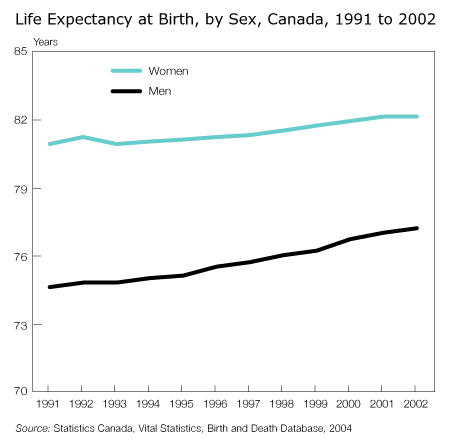
International comparison
The remarkable gains in life expectancy in the G-7 countries over the past four decades are due largely to rising
standards of living, public health interventions, and progress in medical care. According to the OECD, Japan had the
highest life expectancy among G-7 countries in 2002 (81.8 years) followed by Italy (79.9 years) and Canada (79.7
years). The U.S. ranked lowest among G-7 countries at 77.2 years. (OECD, Health Data 2005: Statistics and
Indicators for 30 Countries)
Additional information: Regional variations
There are wide variations in health status indicators within Canada, including life expectancy. For instance, the
Richmond Health Service Delivery Area (RHSDA) in British Columbia leads the way with the highest life expectancy in
Canada at 83.4 years, while the Région de Nunavik in northern Quebec has the lowest life expectancy at 66.7 years, for
both men and women. Placed within an international perspective, these disparities are especially revealing, as RHSDA's
life expectancy would rank at the top of all World Health Organization's
countries, two years higher than the current leader Japan, while the Région de Nunavik would stand between the
Dominican Republic (67.0 years) and Egypt (66.5 years), each ranked
at 111 and 112 out of 191 countries. (Statistics Canada,The Daily, February 1, 2005)
Additional information: Socio-economic determinants
The links between geography, socio-economic characteristics, health behaviours, and health status are complex.
Recent data indicate that Canadian communities with the lowest life expectancies are in the most northern and isolated
parts of Canada and are also characterized by low incomes and a high proportion of the population receiving government
transfer payments. Smoking, heavy drinking, and high mortality rates due to suicides and accidents are also prevalent
in these health regions. The health regions enjoying the highest life expectancies, meanwhile, are typically urban
communities experiencing high population growth and are characterized by higher incomes and educational attainment.
(Statistics Canada, The Daily, February 1, 2005)
Current performance and trends
Over the last decade the proportion of Canadians describing their health as excellent or very good declined among
both men and women in every age group. In 2003, 59.6 per cent of Canadians aged 12 and older reported that they were in
excellent or very good health, down from 62.5 per cent in 2000-01 and 63.3 per cent in 1994-95. The percentage of
Canadians who rated their own health as good increased, however, from 26.5 per cent in 1994-95 to 29.7 per cent in
2002-03.

The percentage of Canadians who rated their health as fair or poor stayed relatively stable from 10.2 per cent in
1994-95 to 10.6 per cent in 2003. People in Canada who reported fair or poor health also reported lower income levels,
infrequent exercise, lower educational attainment and older age. (Statistics Canada, Health Reports, "Regional
Socio-economic Context and Health," 2004)
International comparison
Internationally, Canada ranks second after the U.S. in the percentage of the population reporting their health
status as either good or better. (OECD, Health Data 2005: Statistics and Indicators for 30 Countries)
According to the Joint
Canada/United States Survey of Health, the vast majority in both countries-88.0 per cent of Canadians and
85.0 per cent of Americans-reported that they were in good, very good, or excellent health in 2003.
Americans were slightly more likely to report excellent health than Canadians. This was mainly the result of the
15.0 per cent of Americans aged 65 and older that reported excellent health, almost twice the proportion of Canadians
(8.0 per cent) in the same age group. Overall, the range of health status was more polarized in the U.S. than it was in
Canada. More Americans reported being at either end of the health status spectrum as 26.0 per cent stated they were in
excellent health and 15.0 per cent in fair or poor health compared with 24.0 per cent and 12.0 per cent respectively
for Canadians according to Statistics Canada's Joint Canada/United States Survey of
Health.
Current performance and trends
The prevalence of physical activity among Canadians has significantly increased over the past decade. In 2003,
50.4 per cent of Canadians aged 12 and over were at least moderately physically active during their leisure time, up
7.8 percentage points from the 2000-01 survey and 11.0 percentage points from the 1994-95 survey. (Statistics Canada,
Canadian Community Health Survey, 2004)

Current performance and trends
From 1994-95 to 2003-04, the proportion of Canadian adults considered obese grew from 12.7 per cent to 23.1 per
cent, reaching 5.5 million people. In 2004, about 22.9 per cent of adult men and 23.2 per cent of adult women were
considered obese, indicating few differences between sexes. Rates of obesity were highest, however, for both men and
women in the age group of 45 to 64 years old.
The proportion of Canadians considered overweight also increased slightly during the past three years. In 2004,
36.1 per cent of the adult population aged 18 and over was considered overweight, compared to 32.4 per cent in 2000-01.
(Statistics Canada, 2005)
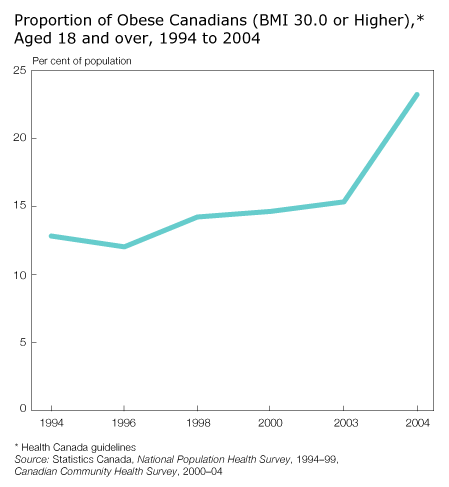
International comparison
Canada is experiencing what the World Health Organization has called a global epidemic of obesity. The prevalence of
obesity is rising not only in western countries such as the U.S., the United Kingdom, Australia, Germany, the
Netherlands, Sweden, and Finland, but also in countries such as Brazil, China, and Israel. According to the OECD, the
U.S. has the highest proportion of adults considered overweight or obese, followed by Mexico, the United Kingdom, and
Australia. (OECD, Health Data 2005: Statistics and Indicators for 30 Countries)
Additional information: Obesity: A growing issue
A recent study based on the National Population Health Survey found that once overweight, Canadians are far
more likely to continue to tip the scales into obesity than reverse the trend and return to their normal weight. In
fact, almost one quarter of Canadians who had been overweight in 1994-95 had become obese by 2002-03. The study also
indicates that only half as many, about 10 per cent, who had been overweight were in the normal weight range eight
years later.
Over the eight years, this translates into more than 1.1 million adult Canadians joining the ranks of the obese.
Between 1995 and 2003, 38.0 per cent of the men whose weight was normal had become overweight compared to 28.0 per cent
of the women. Women (28.0 per cent) were more likely to go from being overweight to being obese than men (20.0 per
cent), but for both men and women being a member of a high-income household was associated with a decreased likelihood
of becoming obese. (Statistics Canada, The Daily, April 7, 2005)
Another study also indicated that the prevalence of Canadians being overweight generally increases the more rural
the region. While the percentage of Canadians being overweight ranged from a low 26.5 per cent in major metro regions,
it rose to over 40 per cent in rural and northern regions. (Statistics Canada, Rural and Small Town Analysis
Bulletin, October 2003)
For more information on obesity, click on the following:
Obesity: A Growing
Issue
Joint Canada/United
States Survey of Health
Current performance and trends
Nationally, the self-reported median wait to consult a specialist (i.e. visits to a specialist for a new illness or
condition) was four weeks. This means that half of the people waited longer and half waited less. The proportion of
individuals who reported that they were affected by waiting for care ranged from 10.0 per cent for non-emergency
surgery to 19.0 per cent for specialist visits. The primary effects of waiting for specialized care were worry, stress
and anxiety, pain, and problems with activities of daily living. The study also indicated that waiting times vary
across provinces. (Statistics Canada, Access to Health Care Services in
Canada, 2004)
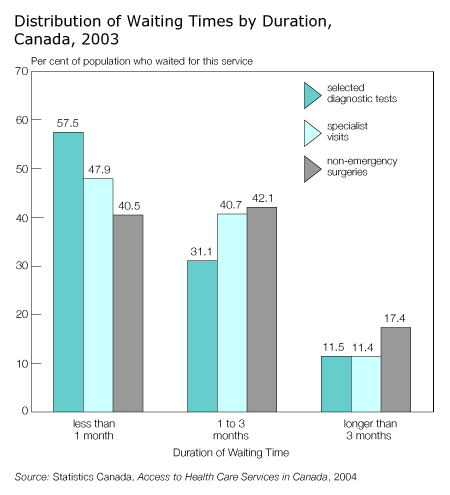
Overall, the majority of Canadians who accessed any of the three specialized services (visit to a specialist,
non-emergency surgery, and diagnostic tests) waited three months or less. Individuals who waited to visit a specialist
or get a diagnostic test were more likely to get care within one month than those waiting for non-emergency surgery.
The comparable self-reported waiting time data at the provincial level indicate that there was some variation in
waiting times across provinces.
Current performance and trends
Between 2000-01 and 2002-03, the percentage of Canadians who rated the quality of overall health services as being
either excellent or good increased from 84.4 per cent to 86.6 per cent. During the same time period, the percentage of
Canadians who reported that they were very satisfied or somewhat satisfied with those services also increased, from
84.6 to 85.3 per cent. (Statistics Canada, Canadian Community Health Survey, 2000-01 and 2003)
Health Expenditures (supplemental indicator)
Current performance and trends
The Canadian Institute for Health Information (CIHI) estimated
that in 2004 Canada spent $130 billion on health care, a $7.0-billion increase from 2003. This 5.0-per-cent increase
represents the lowest rate of annual increase since 1997. This brought health care's share of the total economy-the
GDP-to approximately 10 per cent, a peak first reached in 1992 and repeated in 2003. CIHI estimates for 2004 also shows
health spending in Canada at an average of $4,078 per person. (Canadian Institute for Health Information, Health
Care in Canada 2005)

Public sector spending currently accounts for seven out of every ten dollars spent on health care. In 2004,
governments and social security programs spent $91.1 billion. Public expenditures on health in 2004 were approximately
40 per cent higher than in 1993.
Infant mortality (supplemental indicator)
Current performance and trends
The Canadian infant mortality rate has dropped steadily in the past decade from 6.4 deaths per 1,000 live births in
1991 to 5.2 per 1,000 in 2001. Infant mortality in Canada for 2002, however, was 5.4 deaths per 1,000 live births, an
increase of 0.2 live deaths from the previous year. (Statistics Canada, The Daily, September 27, 2004)

International comparison
Canada ranked sixth among G-7 countries in 2002, with
5.4 infant deaths per 1,000 live births. Only the U.S. had a higher rate at 7.0 per 1,000. (OECD, Health Data 2005:
Statistics and Indicators for 30 Countries)
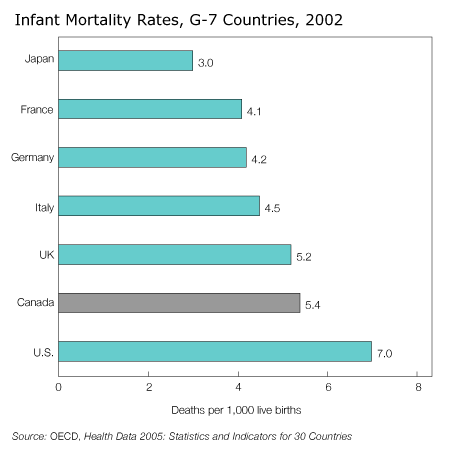
Non-smoking population (supplemental indicator)
Current performance and trends
Smoking has declined substantially over the past decade. In 1994, 29.3 per cent of the Canadian population aged 12
and over smoked either daily or occasionally. By 2003, this had declined to 22.9 per cent.
Some of the biggest declines in daily smoking were among teenagers and young adults, the target of numerous federal,
provincial, and municipal anti-smoking campaigns in recent years. These declines have accelerated in the past
two years. For example, 13.6 per cent of teen girls aged 15 to 19 smoked daily in 2003, down from 18.9 per cent in
2000-01, and 20.9 per cent in 1994. One third (33.2 per cent) of young adults aged 20 to 24 smoked either daily or
occasionally in 2003-the highest rate of any age group. (Statistics Canada, The Daily, Canadian Community
Health Survey, June 15, 2004)
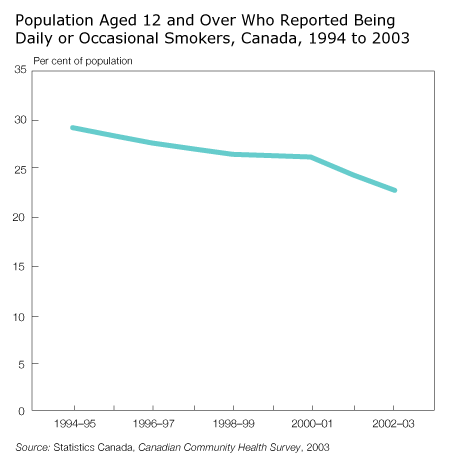
- Attitudes toward diversity
- Volunteerism
- Political participation
- Attitudes toward linguistic duality (supplementary indicator)
- Sense of belonging (supplementary indicator)
- Discrimination and racism (supplementary indicator)
- Mixed unions (supplementary indicator)
- Attitudes toward same-sex marriages (supplementary indicator)
Current performance and trends
As an attitude toward diversity, personal tolerance of others increased slightly between 1991 and 2004. For example,
29.0 per cent of Canadians believe they are more tolerant toward ethnic groups, an increase of 6 percentage points;
65.0 per cent feel there has been no change, an increase of 3.0 per cent; and 8.0 per cent believe they are less
tolerant, a decrease of 2.0 per cent.
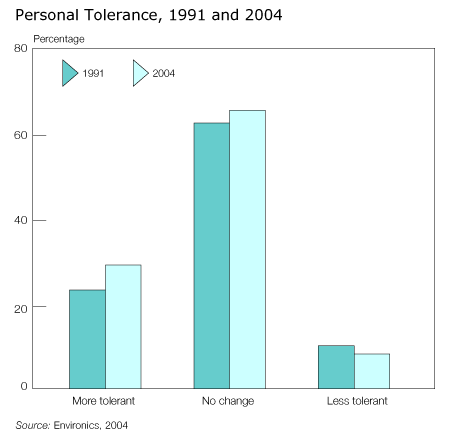
Meanwhile, support for affirmative action and employment equity declined between 1985 and 2004, falling from
44.0 per cent to 28.0 per cent of Canadians agreeing with the idea that "Government should require employers to advance
non-whites to higher positions." (Environics, 2004 Focus Canada-Multiculturalism and Ethnic Tolerance)
Current performance and trends
While the results of the 2004 Canada Survey of Giving, Volunteering and Participation will not be available
until the winter of 2005, the 2000 results of the survey indicated that 27.0 per cent of Canadians volunteered
1.05 billion hours of work in Canada, representing a decrease of 13.0 per cent from 1997.
Additional information on volunteerism
The 2000 results of the National Survey on Giving, Volunteering and Participation indicated that a small
number of people provided the bulk of charitable and voluntary support in the country. Fewer than 1 in 10 Canadians
contributed 46.0 per cent of the total dollar value of all donations as well as 40.0 per cent of all volunteer hours.
In 2000, 27.0 per cent of Canadians volunteered 1.05 billion hours of work, down from 1.11 billion hours in 1997. From
1997-2000, however, the number of hours volunteered increased with the age of the volunteers. The largest increase was
in the over-65 group, who volunteered an average of 269 hours in 2000, up from 202 hours in 1997. In addition, the
number of volunteers dropped from 7.5 million in 1997 to 6.5 million in 2000, a decrease of 13.0 per cent. (National Survey on Giving, Volunteering and
Participating2000; Ethnic Diversity Survey 2002)
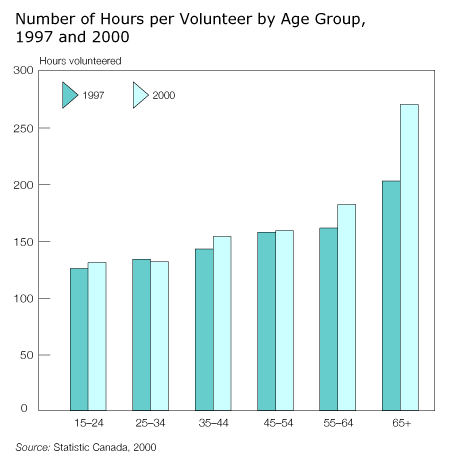
Volunteer labour is very important to Canada's estimated 161,000 incorporated non-profit and voluntary organizations
and registered charities. In 2003, fully 54.0 per cent of these groups operated with no paid staff, reiterating the
importance for Canadians to keep track of volunteering behaviours in Canada. (Statistics Canada, Cornerstone of
Community: Highlights of the National Survey of Non-profit and Voluntary Organizations, 2004)
Current performance and trends
Voter participation in general elections has declined steadily over the past decade, with three quarters of
Canadians voting in the 1997 general election and approximately three fifths voting in the 2004 election.
The voter turnout at the 2004 federal general election was the lowest in recent Canadian history at 60.5 per cent of
eligible voters, down from 61.2 per cent in 2000. Factors such as age, education, income, place of birth, and mobility
significantly influence voter patterns.
A growing number of analysts tend to suggest that such a decline in voter turnout does not necessarily indicate a
decline in civic participation but rather a significant shift, as the political activities that people are engaged in
outside of the polling booth (e.g. petitions signing, public demonstration, boycotts) are garnering more and more
attention.
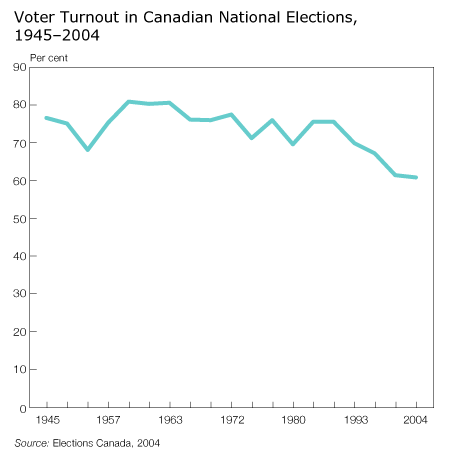

Additional information: Rethinking citizen engagement
Despite a steady decline in voter turnout over the past 15 years, a 2005 Ekos survey stated that Canadians are still
interested in political matters. In fact, 52.0 per cent of Canadians said they were more interested than the average
Canadian in politics and government affairs. This percentage appears to grow with age as 44.0 per cent of the
respondents aged 25 or under said they were interested, 48.0 per cent of those aged 25 to 44, 56.0 per cent of those
aged 45 to 64 and finally, 63.0 per cent of Canadians aged 65 or older were more likely to say they were more
interested in politics and government affairs than the average Canadian. The survey also stated that 68.0 per cent of
Canadians felt there were too few citizen engagement exercises on public policy in Canada, a slight decrease of 5.0 per
cent since 2002. (Ekos, Rethinking Citizen Engagement, April 2005)
According to another study, Canadian citizens do more than show interest, they also express their political
involvement and participation in other ways. When being asked if they had participated in specific types of political
activities over the previous 12-month period, over one quarter of Canadians said they had signed a petition (28.0 per
cent) or searched for information on a political issue (26.0 per cent), while about one in five had attended a public
meeting or boycotted or chosen a product for ethical reasons. Finally, about one in eight Canadians (13.0 per cent) had
expressed their views on an issue by contacting a newspaper or a politician, while 6.0 per cent had participated in a
March or public demonstration. (Statistics Canada, 2003 General Social Survey on Social Engagement, cycle 17-An
overview of findings, July 2004)
Attitudes toward linguistic duality (supplementary indicator)
Current performance and trends
Canadian citizens' views on linguistic duality and support for bilingualism have stayed relatively the same over the
years, according to a report prepared by the Centre for Research and Information on Canada (CRIC). Reviewing data from
five different surveys on the attitudes of Canadians toward language and bilingualism, the CRIC indicated that roughly
eight out of ten Canadians (77.0 per cent) said they believe that preserving English and French as the two official
languages was important, while 70.0 per cent believed that bilingualism made Canada a more welcoming place for
immigrants. Among Canadians born abroad, this latter proportion increased to 75.0 per cent.
The CRIC also observed a number of other trends in a variety of policy areas. While Anglophones who support public
funding of French-language schools outside of Quebec jumped from 14.0 per cent in 1965 to 91.0 per cent in 2002, the
proportion of Canadians who supported the right of all citizens to receive Government of Canada services in their own
official language stayed the same between 1977 and 2002, with a percentage of 80.0 per cent.
Sense of belonging (supplementary indicator)
Current performance and trends
According to an Ekos survey on the sense of belonging, the percentage of Canadians who responded as feeling a strong
sense of belonging to Canada approached the 90 per cent mark and stayed relatively stable from 1994 to 2005 in all
provinces, with the exception of Quebec. In fact, the sense of belonging of what the survey described as ROCers ("Rest
of Canadians," meaning Canadians excluding Quebecers) increased slightly between 1997 and 2005, from 89.0 per cent to
91.0 per cent. Meanwhile, the Quebecers' strong sense of belonging to Canada was somewhat stable only from 1997 to 2001
where it remained at around 55 per cent. After that period, it rose to 63.0 per cent between 2001 and 2003 before
decreasing back to 54.0 per cent in 2005. (Ekos, Rethinking Government, 2005)

Another survey also indicated that with more time spent in Canada, immigrants have a higher sense of belonging to
Canada. The 2002 Ethnic Diversity Survey by Statistics Canada stated that 79.0 per cent of the first
generation of immigrants who arrived in Canada between 1991 and 2001 had a strong sense of belonging to Canada. As for
the first generation of immigrants who arrived in Canada before 1991, the percentage rises to 87.8 per cent of
immigrants saying they feel a strong sense of belonging to Canada.
Discrimination and racism (supplementary indicator)
Current performance and trends
According to the Statistics Canada 2002 Ethnic Diversity Survey, almost 9 out of 10 non-Aboriginal people
in Canada aged 15 years and older (86.0 per cent) stated that they did not feel they had experienced discrimination or
unfair treatment in Canada because of their ethno-cultural background during the previous five years. A total of
7.0 per cent of the population or 1.6 million people, indicated that they felt they had been discriminated against or
treated unfairly, sometimes or often because of their ethno-cultural background. Of this 1.6 million, 576,000 people
also reported visible minority status.
This figure increased for visible minorities since 36.0 per cent of visible minorities said they had experienced
discrimination or unfair treatment sometimes or often in the past five years. Of those who had experienced
discrimination or unfair treatment, 64.0 per cent said that they had experienced such treatment at work or when
applying for a job.
A 2005 Ekos survey found similar results for the past year when very few Canadians (7.0 per cent) reported that they
had been victims of any workplace harassment or racial discrimination in 2004. (Ekos, Rethinking Government,
2005)
Mixed unions (supplementary indicator)
Current performance and trends
Mixed unions are made up of one visible minority and one non-visible minority or two different visible minority
group members. Of the 14.1 million people in couples in Canada in 2001, 452,000 people were in mixed unions (marriages
and common-law unions) or 3.2 per cent of the total of all persons in couples, up from 335,035 in 1991 or 2.6 per cent
of all couples. This represents a 35.0-per-cent increase in mixed unions in 10 years compared with an increase of
10.0 per cent for all people in couples. (Statistics Canada, Canadian Social Trends, 2004)
In terms of attitudes toward inter-racial marriage, both Canada and the U.S. have a similar approval rating-63.0 per
cent in Canada and 65.0 per cent in the U.S. (CRIC, 2003; National Conference for Community and Justice, 2002)
Attitudes toward same-sex marriages (supplementary indicator)
Current performance and trends
An Environics study has indicated that Canadians are narrowly in favour of same-sex marriage. In 2004, 58.0 per cent
of Canadians stated that they strongly or somewhat supported gay and lesbian marriages, compared with 55.0 per cent in
2001. (Environics, Focus Canada, 2004)

After Parliament gave its final approval on June 28, 2005, to a bill that changes the definition of marriage to
include same-sex couples, Canada became the third country in the world, after the Netherlands and Belgium, to openly
recognize gay and lesbian marriage. Two days later Spain followed the footsteps of Canada as the Spanish parliament
passed similar same-sex marriage legislation.
- Participation in cultural and heritage activities
Current performance and trends
Canadians have a wide range of options available to them when choosing what to do in their spare time. Given
emerging technologies and the concurrent development of new leisure pursuits, such as using the Internet, competition
between cultural, heritage, and other leisure activities remains fierce. It becomes equally challenging to present an
up-to-date portrait of participation in various activities since data collected are limited to date. Data are available
from Statistics Canada's General Social Survey for the years 1992 and 1998. Over this six-year period,
cultural participation among the Canadian population aged 15 and over declined in some areas and was on the upswing in
other areas. For instance, reading newspapers declined from 92.1 per cent of the population to 81.8 per cent while
professional concert and performance attendance rose from 30.2 per cent to 34.6 per cent.
Additional information: Attendance at cultural events
Recent survey results from the Performing Arts Survey and the Survey of Heritage Institutions note
small increases in attendance over the late 1990s in some performing arts disciplines and certain heritage
institutions.
The overall attendance reported by performing arts companies between 1999 and 2001 increased 11.0 per cent,
attracting an audience of 14.8 million. Although overall attendance was unchanged between 2001 and 2003, not all
disciplines fared equally. In fact, both attendance and earned revenue increased for theatre, dance, and opera
companies, but they declined for music companies (orchestras, ensembles, choirs). These statistics highlight the
diversity of participation even across different disciplines within the performing arts sector. (Statistics Canada,
The Daily, December 15, 2004)
The 2002 Survey of Heritage Institutions indicated that there were nearly 117.5 million visits to some form
of heritage institution during the year, ranging from museums, historic sites and archives to aquariums and zoos,
botanical gardens, arboretums and conservatories, and nature parks that have interpretation and educational programs.
With the exception of nature parks, attendance increased at every type of heritage institution. Even so, nature parks
attracted over 58.7 million visits while museums and historic sites reported the biggest gains in attendance.
Attendance at museums rose 5.0 per cent in 2002, from 26.5 million to 27.8 million visitors. Historic sites registered
a 4.5 per cent increase from three years earlier, with over 17.4 million visits. (Statistics Canada, The
Daily, October 25, 2004)
While going to the movies still seems to be one of the most popular cultural activities of all, Statistic Canada's
Motion Picture Theatres Survey indicated that attendance at movie theatres and drive-ins combined dropped
4.6 per cent in 2004, halting an upward trend of more than a decade. (Statistics Canada, The Daily, June 28,
2005)
According to a 2004 Decima survey, cultural activities continue to draw sizeable participation as 82.0 per cent of
Canadians (aged 15 and over) attended an artistic performance or exhibit in 2003. The most popular types were live
performances (theatre, music, dance, opera), followed by visual art exhibits. In 2003, festivals were attended by
54.0 per cent of Canadians. In addition, 14.0 per cent of Canadians attended an artistic performance in the minority
official language of their region, and almost half (44.0 per cent) of Canadians attended a live performance or art
exhibit featuring diverse cultures and traditions. (Decima, The Arts in Canada: Access and Availability,
2004)
Additional information: Reading habits
A 2005 Créatec + survey seems to indicate that there is not necessarily a trend toward a lower reading rate in
Canadian society and that the Internet has not had harmful effects on reading habits. In fact, this survey has shown
that reading for pleasure remains a solidly established and widespread habit with little or no change over the last 15
years.
Canadians who took part in this survey generally showed a marked taste for reading all genres, although especially
literary materials such as novels (mystery, science fiction, etc.). Of those polled, 87.0 per cent said they read while
54.0 per cent said they read virtually every day. Canadians appear to be distinctly different from Americans. In the
U.S., where the reading rate has substantially decreased over the past 20 years, nearly 50 per cent of Americans
indicated reading an average of less than one book per year.
Like earlier studies have shown, this survey highlights the substantial influence of certain demographic and social
factors on attitudes to reading books, such as gender, education level, geographical location, and language. For
example, while 51.0 per cent of men indicated being either regular or heavy readers, this percentage rose to 84.0 per
cent among women. (Créatec +, Reading and Buying Books for Pleasure-2005 National Survey)
Additional information: Participation between 1992 and 1998
With the greater variety of such activities offered, Canadians have more options for their leisure time than 10 or
20 years ago. From 1992 to 1998, the period for which the latest comparable data are available, Canadian participation
patterns in cultural and heritage activities changed somewhat.
While overall more Canadians attended professional concerts and performances in 1998 (34.6 per cent from 30.2 per
cent in 1992), participation rates decreased during the same period for theatrical and popular musical performances
(24.0 per cent to 20.0 per cent), going to the opera (4.4 per cent to 3.0 per cent), and for listening to symphonic
music (12.2 per cent to 8.2 per cent). (Statistics Canada, 1998)
In other areas, participation rates were on the rise. More Canadians visited public art galleries (22.1 per cent
from 19.3 per cent) and attended dance performances (6.8 per cent from 4.9 per cent). Canadians also created more of
their own visual arts, with 11.6 per cent painting and sculpting in 1998 compared to 9.6 per cent in 1992. (Statistics
Canada, 1998)
Additional information: Household entertainment and television viewing
One significant trend in cultural and entertainment consumption patterns is the continued shift toward
cocooning, where Canadians continue to spend more on entertainment inside the home than outside the home. For
example, the percentage of household entertainment spending that went to the rental of cablevision and satellite
services increased from 48.0 per cent in 1997 to 53.0 per cent in 2001. (Statistics Canada, Focus on
Culture,Vol. 4, No. 3, 2002)
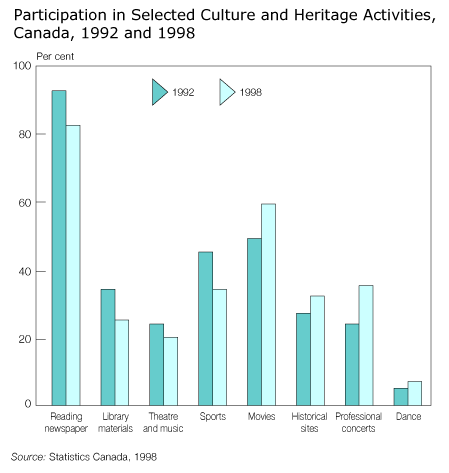
According to the Fall 2003 Television Viewing Survey results, however, this increase in spending on
household entertainment does not seem to translate directly into more television viewing. From 1998 to 2003, the
average hours per week of television viewing has not really changed, hovering around 22 hours per week. As for young
audiences, the study shows that they are actually spending less time in front of their television sets than they did
five years earlier. Young men aged 18 to 24 have gone from an average of 14.3 hours per week in 1998 to 11.1 hours in
2003, while women of the same age reduced their viewing time from 17.6 hours to 15.5 hours during the same period.
(Statistics Canada, The Daily, March 31, 2005)
The survey also suggests that Canadian content on television held relatively steady in 2003 at around 44 per cent
for pay and specialty television and just under 57 per cent for conventional television. In 1998, the same indicators
held at 40.0 per cent and just over 57 per cent respectively.
- Safety
- Housing conditions
Current performance and trends
Based on data reported by police services, Canada's total violent crime rate declined 2.0 per cent in 2004, while
the national homicide rate increased 12.0 per cent. Overall, crime rate fell a marginal 1.0 per cent in 2004.
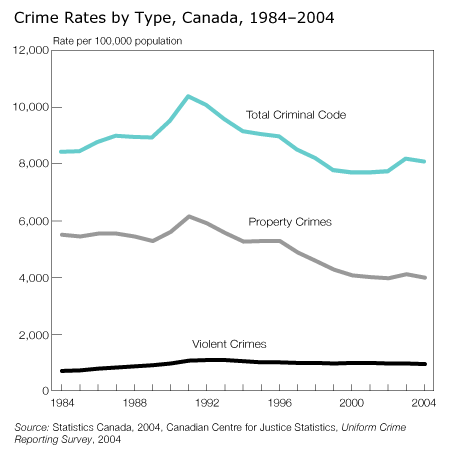
With the exception of a slight increase in 2003, the crime rate has generally been falling since it peaked in 1991.
In 2004, police reported about 2.6 million offences, resulting in a crime rate that was 12.0 per cent lower than a
decade ago.
In total, about 300,000 violent crimes were reported to police in 2004, the majority of which were common assault.
Continuing a general decline since 1991, violent crime rate fell 2.0 per cent from 2003. The violent crime rate is
10.0 per cent lower than a decade ago, but 35.0 per cent higher than 20 years ago.
As for property crimes, police reported nearly 1.3 million last year. The property crime rate dropped 3.0 per cent,
as most categories showed a decline. Property crime has generally been decreasing since 1991, with the exception of a
notable increase in 2003. (Statistics Canada, The Daily,July 21, 2005)
International comparison
A comparison of police-reported crime rates between Canada and the U.S. for 2000 showed that the U.S. had much
higher rates of violent crime, while Canada generally had higher rates of property crime. The report indicated that the
U.S. showed a higher rate of robbery than Canada by 65.0 per cent and a homicide rate (5.5 per 100,000 population)
three times higher than Canada's (1.8 per 100,000 population). Meanwhile, Canada reported 30.0 per cent more break-ins
and motor vehicle thefts per capita than the U.S. (Statistics Canada,Crime Comparisons Between Canada and the
United States, 2000)
Current performance and trends
According to the 2004 General Social Survey, 94.0 per cent of Canadians were satisfied that they were
personally safe from becoming a victim. This proportion was up from 86.0 per cent in 1993 and 91.0 per cent in 1999.
Overall, 95.0 per cent of men were satisfied that they were personally safe from becoming a victim, compared
with 93.0 per cent of women. This gap between sexes is narrowing as the proportion for women rose by five percentage
points between 1999 and 2004, while the proportion for men went up two points.
In 2004, 58.0 per cent of people believed that there had been no change in crime levels, while 30.0 per cent felt
that crime had worsened over the previous five years. These views were fairly consistent with those reported in
the 1999 survey. These perceptions on neighbourhood crime have improved, however, since the 1993 survey, when Canadians
were more likely to say crime was on the rise. At that time, 46.0 per cent felt it had increased.
Additional information: Safety and trust
There appears to be a strong relationship between safety and trust. When trust fades away, people are less likely to
take risks and more likely to fear one another. People therefore tend to demand more protection, they anticipate
inappropriate deeds of others, and they can even make provisions for the possibility of something going wrong.
When Canadians were asked if they would say that "most people can be trusted" or if they felt that "they could not
be too careful in dealing with others," the 2003 General Social Survey found that Canadians are divided on the
subject. Overall, 53.0 per cent of Canadians indicated that people could be trusted while 43.0 per cent stated that one
could not be too careful in dealing with people. No significant variation was observed between gender and age
groups.
(Statistics Canada, Canadian Social Trends, Winter 2004)
People with higher levels of educational attainment and those residing in households with higher incomes, however,
were most likely to say that people could be trusted. Finally, Quebec residents showed the weakest level of trust, at
35.0 per cent, compared with over 60.0 per cent of people in Newfoundland and Labrador, Prince Edward Island, Nova
Scotia and the western provinces who said that people could be trusted.
Current performance and trends
Six of the ten countries that participated in the International Crime Victimization Survey in both 1996 and
2000, including Canada, experienced no change in their victimization rate.
While a total of 24.0 per cent of Canadians reported having been victimized, Australia and England had the highest
rates of all at 30.0 per cent and 26.0 per cent respectively. Portugal, Japan, and Northern Ireland had the lowest
rates, all at 15.0 per cent. Results from the 2004 survey will be available in 2006.
Current performance and trends
Between 1996 and 2001, housing conditions have considerably improved in Canada's 27 largest metropolitan areas,
after deteriorating earlier in the decade. Despite this overall improvement, one out of six households in Canada's
metropolitan areas still lived below one or more housing standards (house adequacy, affordability, and suitability)
established by the Canada Mortgage and Housing Corporation (CMHC).
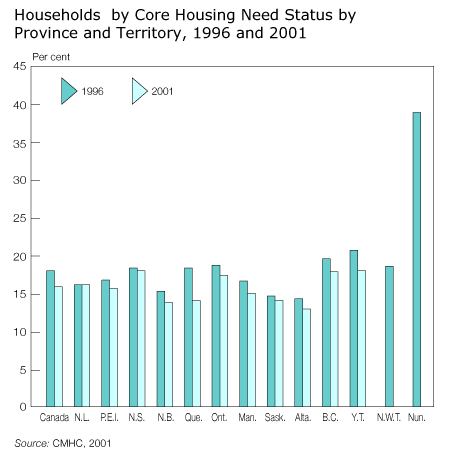
In 1996, 19.0 per cent of households in Canada's metropolitan areas and 17.9 per cent of all of Canada's households
were labelled "in core housing need." Five years later, this proportion had dropped to 16.6 per cent among Canada's
metropolitan areas and to 15.8 per cent for all of Canada's households. Of these households, more than three quarters
were facing affordability issues only. In fact, 9 out of 10 households in urban centres reported that their housing was
not in need of major repairs and that they had an appropriate "bedrooms to members" ratio in accordance with the
National Occupancy Standards. (See the Housing outcome in Aboriginal Peoples Chapter of the report for additional
information.)
Additional information on Canada's social foundations
Early childhood development
Many examples on the joint work initiatives pertaining to young children can illustrate the strength of
collaboration between the federal government, provinces, and territories to improve the well-being of young children
and their families. The Federal/Provincial/Territorial Multilateral Framework on Early Learning and Child
Care, the recent work on the Early Learning and Child Care Initiative, and the Early Childhood Development
Agreement between federal, provincial, and territorial governments were set to improve and expand early childhood
development supports for young children and their parents while providing access to affordable, quality, provincially
and territorially regulated programs and services.
To keep up with these objectives, the Government of Canada is providing $1.05 billion over five years through the
Canada Social Transfer to support provincial and territorial government investments in early learning and child care,
such as child care centres, family child care homes, preschools, and nursery schools. Investments also include capital
and operating funding, fee subsidies, wage enhancements, training, professional development and support, quality
assurance, and parent information and referral. Budget 2005 confirmed that the Canada Social Transfer will be included
in the ongoing allocation of $350 million as of 2007-08. Investments also include capital and operating funding,
quality assurance, parent information and referral, and access to childcare services in the minority official
language.
Environment and its effect on health
Concern about the effect of the environment on health has risen over the last decade, as 61.0 per cent of Canadians
now feel that their health is currently either affected "a great deal" or "a fair amount," up from 52.0 per cent in
1992. (Environmental Monitor, 2002-3)
Canadians are also pessimistic about the effect of environmental problems on the health of future generations. A
large majority of Canadians (89.0 per cent) agree that environmental pollution is already affecting their children's
health, down 5.0 per cent from 1999. More recent evidence supports this finding and shows that 91.0 per cent of
Canadians continue to report that environmental problems will affect the health of their children and grandchildren "a
great deal" (63.0 per cent) or "a fair amount" (28.0 per cent). (Environmental Monitor, 2003-1)
Immigration
Over the last century, immigration has played a major role in Canada's ethnic and cultural composition. Between 1901
and 2001, Canada has welcomed more than 13.4 million immigrants. In 2001, Canada ranked second in the world after
Australia on the proportion of population born outside the country. According to Australia's 2001 Census, 22.0 per cent
of its population was foreign-born, compared with 18.0 per cent for Canada (5.4 million people). In contrast, only
11.0 per cent of the population of the U.S. was foreign-born in 2000.
Half a century ago, a vast majority of the immigrants coming to Canada were from European countries such as the
United Kingdom or Germany, a trend that has significantly shifted in recent years as newcomers now tend to be from
Asian countries. Of the 1.8 million immigrants who arrived between 1991 and 2001, 58.0 per cent came from Asia
(including the Middle East), 20.0 per cent from Europe, 11.0 per cent from the Caribbean, Central, and South America,
8.0 per cent from Africa, and 3.0 per cent from the U.S. (Statistics Canada, 2001 Census)
Gender equality in the world
A 2005 World Economic Forum study has revealed that Canada is not alone in its quest for gender equality as no other country has yet managed to
eliminate the gap between genders. Sweden (ranked 1st) and other Nordic countries, which stand out as world leaders in
narrowing such a gap, still have significant gender disparities. Overall, Canada ranked 7th among 58 countries in its
attempt to promote the equality between men and women. Canada ranked ahead of the United Kingdom (8th), Germany (9th),
France (13th), and the U.S. (17th). Based primarily on the findings of the United Nations Development Fund for Women
(UNIFEM), the study relied on the following measurements of criteria: economic participation, economic opportunity,
health and well-being, educational attainment, and political empowerment.
(World Economic Forum, Women's Empowerment: Measuring the Global Gender Gap, 2005)
Total expenditures on culture
The federal government promotes Canadian culture, arts and heritage, both domestically and internationally. In
2002-03, the federal government's total expenditures on culture increased 6.5 per cent from the previous year
to $3.4 billion. In 2003-04, the financial support provided to Canadian artists from the Canada Council for the Arts
reached $137.0 million.
Total federal government expenditures on culture include the entire spectrum of cultural, artistic and heritage
activities, such as national, public and school libraries, museums, public archives, historic and nature parks and
sites, literary arts, performing arts, arts education, visual arts, films and videos, broadcasting, sound recording,
cultural facilities, centres, festivals and others. For more details, see Statistics Canada's The Daily,
January 27, 2005.
National Homelessness Initiative
By the late 1990s, homelessness was becoming a crisis in many Canadian cities. In response, the federal government
created the National Homelessness Initiative (NHI) in 1999
to support governments and community organizations in their work to alleviate homelessness. Since then, communities
across Canada have undertaken over 3,242 projects, funded wholly or in part by the NHI. These projects have resulted in
approximately 10,700 new, permanent beds in shelters, transition homes, and supportive houses. Overall, 1,287
sheltering facilities and support facilities, such as food banks, soup kitchens, and drop-in centres, have benefited
from the NHI funded projects. (NHI, 2005)
Family violence
In 2002, there were more than 205,000 victims of violent crime reported by the 94 different police departments
across Canada participating in the incident-based Uniform Crime Reporting Survey, which collectively accounts
for more than half (56.0 per cent) of the national volume of police-reported crime. (Statistics Canada, Family
Violence in Canada: A Statistical Profile, 2004)
Research has also shown that even though they represent 23.0 per cent of the population, children and youth under
the age of 18 accounted for 61.0 per cent of victims of sexual assault and for 20.0 per cent of all victims of physical
assault. Among family-related sexual assaults reported to police departments, girls represented 79.0 per cent of the
victims. Rates of sexual offences were highest among girls between the ages of 11 and 14 and between the ages of 3 and
7 for boys.
The study also highlights the fact that witnessing violence in the home has been found to be related to short- and
longer term problems in children's behaviour, such as aggression, anxiety, and emotional problems.
Victim services
According to the first-ever one-day snapshot Victim Services Survey, victim service agencies across Canada
helped more than 360,000 people affected by crime in 2002 and 2003. The most common types of services offered across
all types of agencies were emotional support to the victims as well as multiple types of information on courts
procedures and on the structure and process of the criminal justice system. In some cases, victim service workers also
accompanied clients to court or assisted them in preparing impact statements.
Results of this survey showed that on the survey snapshot day of October 22, 2003, more than three quarters of the
people who sought assistance were victims of violent crime, either directly or indirectly. Most of them were women and
girls. In fact, even when clients of sexual assault centres were excluded from the total, the figures indicated that
women still accounted for over 7 in 10 victims helped that particular day. As for the children under 18 years of age,
they accounted for 18.0 per cent of those helped by victim service agencies on that same day. (Statistics Canada,
The Daily, December 2004)
Hate-motivated crimes
Twelve of Canada's major police forces across the country reported 928 incidences of hate-motivated crime in 2001
and 2002. This includes the period just after September 11, 2001, when police agencies observed heightened levels of
hate-motivated crime, with 15.0 per cent of incidences following September 11 directly attributed to those events. For
the total number of hate-motivated crimes tracked in 2001-02, more than half (57.0 per cent) were motivated by racial
and ethnic origins, 43.0 per cent involved religious motivations, and issues of sexual orientation motivated 10.0 per
cent. During the period of tracking, Jewish people and establishments were the most frequently targeted as a single
group, accounting for one quarter of the incidences of hate-motivated crime.
Members of visible minorities report fearing being the victim of a hate-motivated crime that targeted ethnicity,
language, or religion at a percentage rate more than twice that of Canadians generally, and fears of victimization are
also heightened for members of Hindu, Jewish, and Muslim religions. (Statistics Canada, 2004)
|
